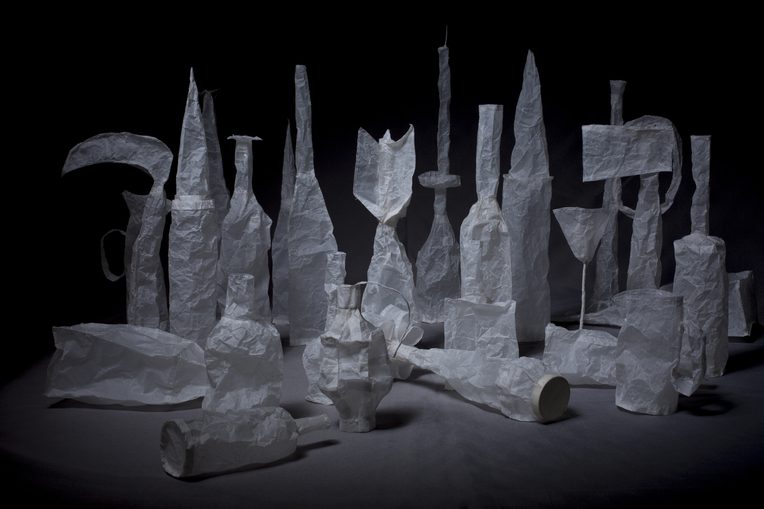Aesthetics
From the Series: Keywords for Ethnography and Design
From the Series: Keywords for Ethnography and Design

What might a shift from design to aesthetics do for thinking about ethnography? What tensions or overlaps exist among art, design, and ethnographic objects? What does a consideration of ethnographic aesthetics vis-à-vis design suggest about ethnographic practice?
Aesthetics in the Western philosophical tradition comes from the Greek aisthesis, meaning sensation or perception. Immanuel Kant used the term in discussions of art to argue that beauty derives from an artwork’s formal aspects rather than social convention or subjective judgment. Beautiful things, he notes, have “purposiveness without a purpose” (Kant 1969, 57). Any practical use or physical response aroused by an object thus disqualifies it from an aesthetic realm in which beauty is enjoyed through the free play of mental faculties. In this formulation, form holds a hierarchical relation over function. The colonizing universalization of this Western bourgeois system of perception and evaluation conceptually fused aesthetics with the detached art object. It held that an aesthetics of form over function only properly pertained to Western culture, with function over form predicated as the non-Western norm (Sharman 1997). It drew disciplinary borders between art history and anthropology, art object and artifact, the West and the rest.
Modernist design thinking inverted this hierarchy of aesthetics in an oft-repeated principle—what Louis Sullivan called the “law of all things,” that “form ever follows function.” This 1896 declaration, made in reference to the rise of the skyscraper, turned a specific conjunction of social, political, and economic forces into yet another universal law, one still pervasive in architecture, product, and software design. These philosophies of aesthetics and design ran parallel to one another in shaping a Western telos. The assumed neutrality of modernist design produces an aesthetics of its own, in which certain functions—say, containment over complexity—prevail (e.g., McPherson 2012). A well-designed thing structures what is perceived as proper social functioning.
The anthropology of art as a subfield, with its focus on the traditions of non-Western cultures, cleaved to a colonial order of things until ethnographic attention to aesthetics as social practice began to deconstruct universalized histories of sensation or perception. Marilyn Strathern’s (1990) analysis of aesthetics in Melanesian sociality describes a shared appreciation of appropriate form. In gift exchange, it is the quantity and quality of wealth together with how it is accumulated and revealed that make aesthetic sense. An anthropology of aesthetics attends to creative work “in the double sense of purposive, relational activity and its object in some kind of sensory intervention in the way people respond to the world” (Strathern 2014, 261). Ethnographic aesthetics, then, involves epistemological reflection on hierarchies of form and function; ethnography as social process and representational object; and the relational aesthetics of those implicated in the ethnographic endeavor.
My ethnographic work with Chinese contemporary artists, at a moment when the social role of art turned from revolutionary nationalism to culture industry formation, traces the layered aesthetics shaping semicolonial, communist, and postsocialist worldings (Welland 2018). The cultural encounters involved reorient global art through Mao Zedong’s exhortation to culture workers to enter the life of the common people and expose their enemies, and to create art that would be the result of “the revolutionary’s mind reflecting and processing popular life” (McDougall 1980, 68–69). Artworks, in this formulation, are anything but disinterested. They reorder the world; they shift consciousness; they overturn colonial and class relations.
I met Lei Yan at the sixth site of The Long March, a 2002 art exhibit that followed the route of the Red Army’s 1934 trek to establish a rural guerrilla base in Yan’an. Its curators invited U.S. artist Judy Chicago to join Chinese artists in a village in Yunnan to explore a feminist theme of her choosing. After a thirty-year career as an art-soldier in the Chinese military, Lei responded to Chicago’s universalizing hypothetical—“If Women Ruled the World”—with a pair of images: What If the Long March Had Been a Women’s Rights Movement? and What If They Had Been Women? The first features female activists who joined the Long March; the second shows male party leaders, in the same field, adorned with 1930s female hairstyles. A regiment of female soldiers marches in the background of each image, in opposite directions. Lei shifts the subjunctive mood of Chicago’s construction to the past unreal conditional, rooting dreams for future justice in historically specific conditions. The camouflage-dressed figure of the artist, peering through binoculars at her predecessors, appears in the bottom corner of each photograph.

Lei Yan’s roaming over the contested terrain of aesthetics also performs an autoethnographic excavation of the formal arrangements that made her as both artist and woman. Her montage gives form to the complex intentionalities and instabilities of form—its expression of rightness and moral order, of hierarchy and hegemony, of recognition, resistance, and revolution—what Alfred Gell (1998) calls “art’s agency.” She has inspired my thinking about ethnographic aesthetics. How do we give shape to the multiple, affecting pasts and futures of form in which we work? How do the forms we use set up the world? To my opening question about art, design, and ethnographic objects, Lei provides a response with images like the one above, a serial, ghostly assembly of hallowed and hollowed forms of revolutionary aesthetics.
Gell, Alfred. 1998. Art and Agency: An Anthropological Theory. New York: Oxford University Press.
Kant, Immanuel. 1969. Critique of Judgment. Translated by James Creed Meredith. New York: Oxford University Press. Originally published in 1790.
McDougall, Bonnie S., ed. 1980. Mao Zedong’s “Talks at the Yan’an Conference on Literature and Art”: A Translation of the 1943 Text with Commentary. Ann Arbor: University of Michigan Center for Chinese Studies.
McPherson, Tara. 2012. “Why Are the Digital Humanities So White? Or, Thinking the Histories of Race and Computation.” In Debates in the Digital Humanities, edited by Matthew K. Gold, 139–60. Minneapolis: University of Minnesota Press.
Sharman, Russell. 1997. “The Anthropology of Aesthetics: A Cross-Cultural Approach.” Journal of the Anthropological Society of Oxford 28, no. 2: 177–92.
Strathern, Marilyn. 1990. The Gender of the Gift: Problems with Women and Problems with Society in Melanesia. Berkeley: University of California Press.
_____. 2014. “Reflections.” In Arts and Aesthetics in a Globalizing World, edited by Raminder Kaur and Parul Dave-Mukherji, 259–64. New York: Bloomsbury Academic.
Welland, Sasha Su-Ling. 2018. Experimental Beijing: Gender and Globalization in Chinese Contemporary Art. Durham, N.C.: Duke University Press.